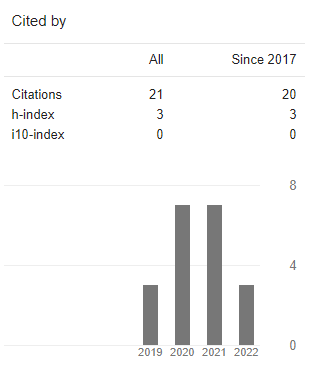A Strong Independent (Video Game) Woman Examining Red from Transistor (2014)
DOI:
https://doi.org/10.21776/ub.alphabet.2019.02.01.02Keywords:
video game, gender representation, sexualisation, objectification, TransistorAbstract
In the 21st century, gender representation in video games has improved as a response to growing criticisms of stereotyped, denigrating portrayals of women. Despite this progress, some of these depictions persist in female characters who appear in the medium, even within the independent (indie) video game scene. Examining Red as the protagonist of the independent role-playing game Transistor (Supergiant Games, 2014) through a semiotic lens, this paper investigates whether her character is in accordance with the prevailing trend of gender representation, especially as it pertains to sexualization and objectification. This paper argues that rather than sexualizing Red, the narrative and visual aspects of Transistor characterize her as a complex, powerful heroine. Moreover, she initially expresses a high level of autonomy in the game, subverting the damsel-in-distress trope. However, she ultimately loses her agency and succumbs to her dependency towards her male lover. As such, Red embodies contradictory concepts of empowerment and helplessness. This indicates that despite originating from an independent studio, the portrayal of Transistor’s protagonist is still in line with the broader paradigm of gender representation in video games. Specifically, it challenges certain harmful stereotypes of women while reaffirming some of them.
References
American Psychological Association, Task Force on the Sexualization of Girls. (2007). Report of the APA task force on the sexualization of girls. Retrieved from http://www.apa.org /pi/women/programs/girls/report-full .pdf
Campbell, N. (2014). Finding her voice: Red’s agency in Transistor. Retrieved from http:// nis-sacam.com/post/88005598503/finding-her-voice-reds-agency-in-transistor
Dean, P. (2013). Tropes vs women in video games: Why it matters. Retrieved from https:// www.ign.com/articles/2013/05/31/tropes -vs-women-in-video-games-why-it-matters
Dietz, T.L. (1998). An examination of vio-lence and gender role portrayals in video games: Implications for gender socializa-tion and aggressive behavior. Sex Roles, 38(5-6), p. 425. https://doi.org/10.1023/A:10187099 05920
Downs, E. & Smith, S.L. (2009). Keeping abreast of hypersexuality: A video game character content analysis. Sex Roles, 62(11–12), pp 721–733. https://doi.org/10.1007/ s11199-009-9637-1
Eichner, S. (2014). Agency and media reception: Experiencing video games, film, and television. Springer VS.
Friedberg, J. (2015). Gender games: A content analysis of gender portrayals in modern, narra-tive video games (Thesis). Georgia State University. Retrieved from https:// schol-arworks.gsu.edu/sociology_theses/52
Gitelman, E. R. (2014). Beyond princess peach: Gender issues and the boy's club hegemony of video game development (Thesis). Depart-ment/ Program: Art History, Theory and Criticism. The School of the Art Institute of Chicago.
Han, H. & Song, S. (2014). Characterization of female protagonists in video games: A focus on Lara croft. Asian Journal of Wom-en's Studies, 20(3), https://doi.org/10.1080/ 12259276.2014.11666189
Jansz, J. & Martis, R. G. (2007). The Lara phenomenon: Powerful female characters in video games. Sex Roles, 56(3–4), pp 141–148. https://doi.org/10.1007/s11199-006-9158-0
Lynch, T. et al. (2016). Sexy, strong, and sec-ondary: A content analysis of female char-acters in video games across 31 years. Journal of Communication, 66(4), pp 564-584. https://doi.org/10.1111/jcom.12237
Mackenzie, C. and Stoljar, N. (2000). Rela-tional autonomy: Feminist perspectives on auton-omy, agency, and the social self. Oxford Uni-versity Press.
Mears, B. N. (2017). Design patterns for silent player characters in narrative-driven games (Thesis). Drexel University.
Mou, Y. (2007). Gender and racial stereotypes in popular video games. Michigan State Univer-sity.
Nicholl, G. A. (2017). A content analysis of gen-der representations in independent video games. Sam Houston State University.
Nussbaum, M. (1995). Objectification. Phi-losophy & Public Affairs, 24(4), pp 249-291. Retrieved from http://www.jstor .org/stable/2961930
Pirkis, J., Francis, C., Dunt, D., and Blood, R. (2005). A review of the literature regarding film and television drama portrayals of suicide. The University of Melbourne.
Rajkowska, P. (2014). Roles of female video game characters and their impact on gender repre-sentation (Dissertation). Retrieved from http:// urn.kb.se/resolve?urn=urn:nbn:se:uu:diva-225393
Sainsbury, M. (2016). The Friday Ten: Ten qual-ity feminist games. Retrieved from http://www. digitallydownload-ed.net/2016/09/the-friday-ten-ten-quality-feminist.html
Sarkeesian, A. (2013). Full IGN interview with Anita Sarkeesian. feminist frequency. Re-trieved from https://feministfrequency .com/2013/06/06/full-ign-interview-with-anita-sarkeesian/
Sarkeesian, A. (2013). Damsel in Distress: Part 1 - tropes vs women in video games [Video File]. Retrieved from https://www.Youtube.com /watch?v=X6p5AZp7r_Q&list=PLn4ob_5_ttEaA_vc8F3fjzE62esf9yP61
Seraphine, Frederic. (2014). The Intrinsic Semi-otics of Video-Games. 10.13140/RG.2.2. 19968.02560/1.
Supergiant Games. (2014). Transistor [Com-puter Software]. San Fransisco, California.
Supergiant Games. (2014). Transistor - Launch Trailer [Video File]. Retrieved from https://www.youtube.com/watch?v=RT55lch6y_U
Vella, D. (2016). A structural model for player-characters as semiotic constructs. Digital Games Research Association. Retrieved from http://todigra.org/index.php/todigra/article/view/37/94




















